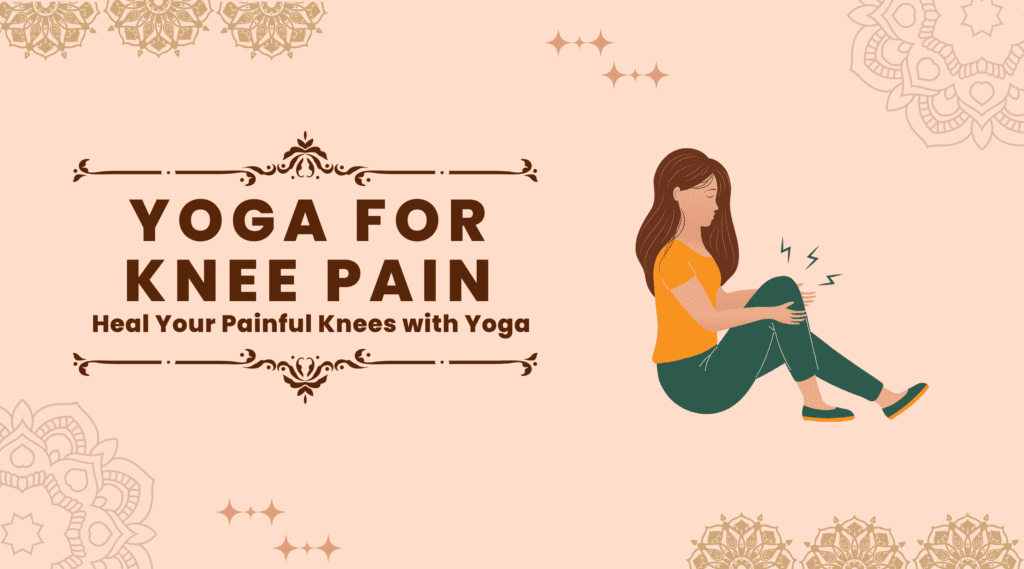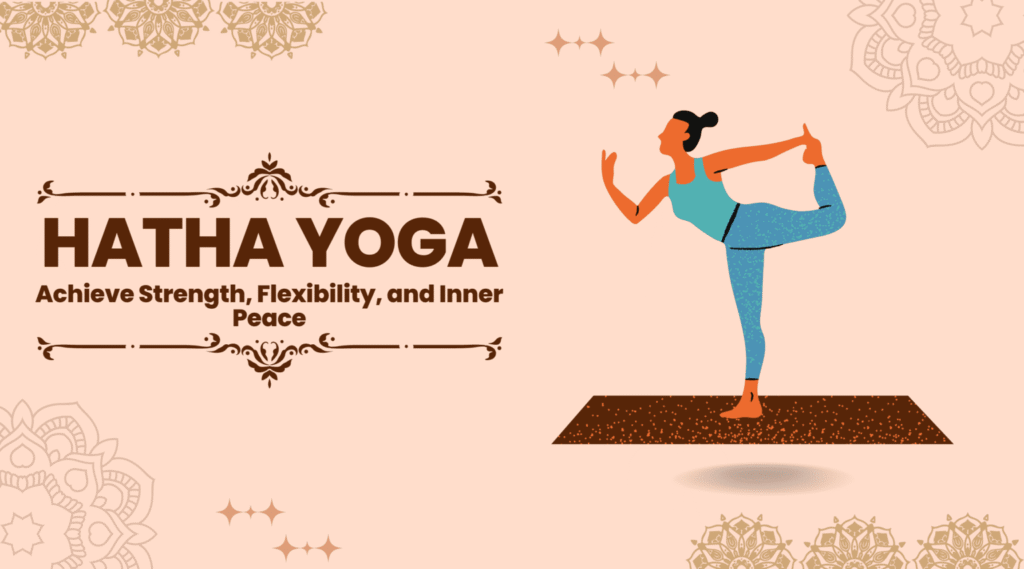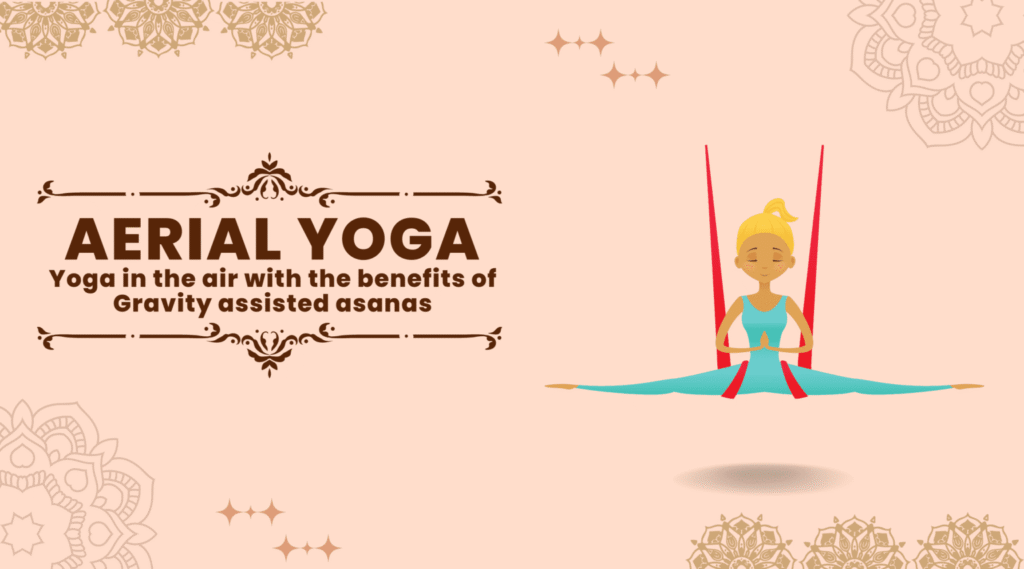
Introduction
People of all ages frequently suffer from knee pain. This pain can greatly impact your daily life as well as limit your mobility. Knee pain can occur due to a variety of reasons such as injury, overuse, arthritis, or poor posture or prolonged periods of standing or sitting.
Knee pain can be acute that lasts for a short period or chronic lasting for months or even years. In this condition, yoga for painful knees proves to be a great help.
Yoga has gained immense popularity as a natural and effective means of managing pain as well as improving overall well-being. It offers a holistic approach to address knee pain by combining gentle movements, stretching, strengthening and mindfulness.
Here, in this blog post, we’ll explore various yoga poses, their benefits as well as tips to alleviate knee pain.
Symptoms of Knee Pain
Knee pain can range from a dull ache to sharp, stabbing pain. Other symptoms may include swelling, stiffness, redness, and difficulty moving the knee joint. Knee pain can impact a person’s quality of life by limiting mobility and causing discomfort.
Runner’s Knee
Runner’s knee is a common term used to describe several different knee problems that can affect runners and even other athletes who engage in high-impact activities that involve a lot of running or jumping.
The most common type of runner’s knee is patellofemoral pain syndrome, which is characterised by pains in the kneecap or patella. Patellofemoral pain syndrome occurs when the kneecap does not move properly and rubs against the femur bone, causing irritation and pain.
This can be caused by a number of factors, including overuse, weak thigh muscles, poor running technique, or structural abnormalities in the knee joint.
Other types of runner’s knee include iliotibial band syndrome and patellar tendinitis.
Iliotibial band syndrome occurs when the iliotibial band, a thick band of tissue that runs from the hip to the knee, becomes tight and inflamed. This causes pain on the outside of the knee and is often caused by overuse or poor running technique.
While patellar tendinitis is an injury to the patellar tendon, which connects the kneecap to the shinbone. This can be caused by overuse, sudden changes in training intensity, or poor running technique.
How Yoga Helps in Runner’s Knee
Yoga for painful knees can be a quite helpful complementary therapy for runner’s knee, as it can help improve flexibility, strength, and balance in the body. Here are the ways through which yoga can help in runner’s knee:
Suggested: Best Yoga Retreats And Yoga Teacher Training In Rishikesh
1. Stretching: Many yoga poses involve deep stretching of the hips, hamstrings, and quadriceps, which can help alleviate tightness and improve range of motion in the knee joint.
2. Strengthening: yoga poses, such as Warrior II and Chair pose, can help strengthen the muscles of the legs and hips, which can help support the knee joint during running and other high-impact activities.
3. Balance: Yoga poses that require balance, such as Tree pose and Eagle pose, can help improve balancing of the body while performing high impact activities. As a result it helps prevent falls as well as other injuries.
Yoga for Knee Pain Relief
Yoga can be a useful tool in managing knee pain. By strengthening the muscles around the knee joint, improving flexibility, and reducing inflammation Yoga helps in giving knee pain relief.
Here we will discuss a few yoga asanas (yoga poses) which are beneficial in knee pain:
1. Virabhadrasana II (Warrior II Pose)
This posture is excellent for strengthening the muscles around the knee joint.
To do this posture, stand with your feet about three feet apart. Turn your right foot out to 90 degrees and your left foot in slightly.
Bend your right knee and make your thigh parallel to the ground.
Raise your arms to shoulder height and look over your right hand. Hold the posture for 30 seconds to a minute, then repeat on the other side.
2. Trikonasana (Triangle Pose)
This posture stretches and strengthens the muscles around the knee joint.
To do this posture, stand with your feet about three feet apart. Turn your right foot out to 90 degrees and your left foot in slightly.
Reach your right hand towards your right ankle or shin and extend your left arm towards the ceiling.
Keep your knees straight and hold the posture for 30 seconds to a minute, then repeat on the other side.
3. Balasana (Child’s Pose)
This posture helps to stretch and release tension in the knees.
To do this posture, kneel on the floor with your big toes touching and sit on your heels.
Lean forward and put your forehead on the ground. Stretch your arms out in front of you and hold the posture for 30 seconds to a minute.
4. Setu Bandha Sarvangasana (Bridge Pose)
This posture helps to strengthen the muscles around the knee joint and improve flexibility in the hips.
To do this posture, Lay down on the ground with your back, keep your knees bent and your feet flat on the floor.
Raise your hips towards the ceiling, keeping your shoulders and head on the floor. Be in the posture for 30 seconds or a minute.
5. Viparita Karani (Legs Up the Wall Pose)
This posture helps to reduce inflammation in the knees and improve circulation in the legs.
To do this posture, lie on your back with your legs up against a wall. You should keep your buttocks as close to the wall as possible.
Stay in this position for a period of 5 to 10 minutes.
6. Utkatasana (Chair Pose)
Chair pose is a yoga pose that strengthens the legs, glutes, and core muscles.
To do this pose, first of all stand tall with your feet hip-distance apart and your arms at your sides.
Now inhale and raise your arms straight up overhead, keeping your palms facing each other.
Now exhale and bend your knees, as if you were sitting into an imaginary chair.
Keep your knees aligned over your ankles and your thighs parallel to the floor. Keep your weight in your heels and press your shoulder blades down your back.
Stay in this pose for some time and then release the pose with an exhale.
7. Tadasana (Mountain Pose)
Tadasana, also known as Mountain pose, is a foundational yoga pose that is often used as a starting point for other standing poses. It can help improve posture, body awareness and stability.
To do this pose, Stand straight with your feet at a hip-distance and your arms along sides.
Now spread your toes wide and press them down into the ground, creating a stable base for the pose.
Engage your leg muscles and lift your kneecaps up, which will help activate the muscles of your thighs and glutes.
Draw your navel in toward your spine and lift your chest, lengthening your spine and creating space between your vertebrae.
Roll your shoulders back and down, allowing your shoulder blades to slide down your back. Relax your arms at your sides, with your palms facing forward.
Now perform deep breathing for some time while focusing on the sensation of grounding down through your feet and lifting up through the crown of your head.
8. Virasana (Hero Pose)
Virasana, also known as Hero pose, is a gentle seated yoga pose that stretches the thighs, ankles, and knees. It improves flexibility, circulation in the legs and mobility in the lower body.
To do this pose, start by kneeling on your mat with your knees together and your feet slightly wider than hip-distance apart.
Now sit back on your heels, placing a block or folded blanket between your calves and thighs if necessary to relieve any discomfort in your knees.
Lengthen your spine and lift your chest, drawing your shoulder blades down your back. Rest your hands on your thighs, or bring your palms together in front of your heart in a prayer position.
Hold this yoga posture while doing deep breathing, relaxing your body and allowing your legs to release any tension.
To deepen the stretch, you can lean back slightly and place your hands on the floor behind you, or come forward and fold your torso over your thighs.
9. Ardha Chandrasana (Half Moon Pose)
Ardha Chandrasana, also known as Half Moon pose, is a standing yoga pose. It is a challenging pose that can help improve coordination, flexibility, stability, balance and strengthens the legs, core, and hips.
To do this pose, start in Trikonasana (Triangle pose) with your front foot pointing forward while your back foot at a 45-degree angle.
Now place your hand on a block or the floor next to your front foot as well as shift your weight onto your front leg.
Lift your back leg, keeping it parallel to the ground, and extend your top arm toward the sky. Keep gazing your top hand and engage your core and leg muscles to maintain your balance.
Hold the posture for some time, then slowly lower your back leg and return to Trikonasana.
To deepen the stretch, you can lift your bottom hand off the ground and bring it to your hip or extend it toward the sky.
10. Baddha Konasana (Butterfly Pose)
Baddha Konasana, is also known as Bound Angle pose or Butterfly pose. It is a seated yoga pose that stretches the inner thighs as well as groynes. It can help improve flexibility and mobility in the hips.
To do this pose, start with a seated position on your mat with your legs extended in front of you.
Now bend your knees and bring the soles of your feet together while allowing your knees to fall open to the sides.
Grasp your ankles or feet with your hands and draw your heels toward your pelvis as close as comfortable.
Sit up tall, lengthening your spine and lifting your chest while drawing your shoulder blades down your back.
Press your knees toward the ground, using your elbows to gently push down on your thighs if necessary.
Stay in the posture for some time. During the posture, allow your body to relax and release any tension in your hips.
To deepen the stretch, you can gently fold forward, resting your hands on the floor in front of you or placing a block or cushion under your forehead for support.
11. Marjaryasana/Bitilasana (Cat/Cow pose)
Marjaryasana/Bitilasana, also known as Cat/Cow pose, is a gentle yoga flow that stretches and mobilises the spine. This can help improve flexibility as well as mobility in the neck, shoulders, and hips.
To do this pose, start the asana with your hands and knees. Put your wrists under your shoulders while keeping your knees under your hips.
Now inhale and lift your head and tailbone, arching your back and stretching your chest and belly down toward the ground (Cow pose).
Exhale and round your spine, tucking your chin toward your chest and bringing your tailbone toward your knees (Cat pose).
Continue flowing back and forth between Cow and Cat pose with each inhale and exhale, moving slowly and mindfully.
You can also add some movements to the pose, such as circling your hips or shoulders or extending one arm and the opposite leg while in Cow pose.
Then bring them back to the starting position while in Cat pose.
Do deep breathing throughout the flow, allowing your body to move with your breath.
12. Vrksasana (Tree pose)
Tree pose is a standing yoga posture that is also known as Vrksasana. It improves balance, focus, and stability. It also helps to strengthen the legs and core muscles, and hence helps in knee pain.
To do this pose, begin with Tadasana or Mountain pose, standing tall with your feet hip-width apart, and your arms by your sides.
Now put your weight on your left foot and simultaneously, lift your right foot off the ground.
Place the sole of your right foot on the inside of your left thigh, as high as you can, while keeping your hips facing forward.
Press your right foot into your left thigh while your left thigh back into your right foot, to create a sense of stability and balance.
Bring your hands to your heart centre in prayer position or extend them overhead while keeping your shoulders relaxed away from your ears.
Be in the pose for 30 seconds to 1 minute, then release the pose and repeat it for the other side.
13. Adho Mukha Svanasana (Downward facing dog pose)
Downward dog, also known as Adho Mukha Svanasana, is a popular yoga pose that is often a part of a yoga flow sequence as a resting pose.
This yoga pose stretches the hamstrings, calves as well as spine. It also strengthens the arms, shoulders and wrists. This is also a great pose for stretching out the back of the body, especially after sitting for long periods of time.
To do this pose, Start the posture on your hands and knees while placing your knees and wrists directly beneath your hips and shoulders respectively.
Put your palms on the ground as well as spread your fingers widely. In an inverted V position, lift your knees off the floor and straighten your legs.
Don’t worry if your heels don’t touch the ground when you press yourself to the ground.
Hold the pose for 5-10 breaths, then release by bringing your knees back down to the ground.
Home Remedy for Knee Pain
Apart from Yoga practice, home remedies can also be a great help in the condition of knee pain. There are many home remedies that can be beneficial in the condition of knee pain:
1. Hot and Cold Therapy: Applying a hot or cold compress to the knee helps reduce both pain and inflammation. You can use a heating pad, hot water bottle or warm towel for heat therapy while a cold pack or bag of ice wrapped in a towel for cold therapy.
2. Epsom Salt Bath: Adding Epsom salt to a warm bath can help reduce knee pain and swelling. Because Epsom salt contains magnesium and hence, it helps relax the muscles as well as reduce inflammation.
3. Turmeric: Turmeric contains a compound called curcumin, which has anti-inflammatory properties that can help alleviate knee pain hence it is good to add turmeric to food or it can also be taken as a supplement.
4. Massage: Massaging the knee with a topical cream or oil helps improve circulation as well as reduce pain and inflammation.
5. Weight Management: Maintaining a healthy weight can reduce the pressure on the knee joint and as a result, it helps alleviate knee pain. Losing weight through a healthy diet and exercise can be beneficial.
Conclusion
Yoga can be a beneficial and effective practice for people suffering from painful knees. Generally, through the use of gentle stretching, strengthening exercises and breathing techniques, yoga helps improve flexibility. It also increases the range of motion, as well as reduces pain and inflammation in the knee joint.
Certain yoga poses, such as downward dog, tree pose, and warrior pose, can be particularly helpful for targeting the muscles and ligaments surrounding the knee. Apart from yoga, incorporating other natural remedies such as hot and cold therapy, massage, and stress reduction techniques can also aid in the management of knee pain.
However, if the problem persists, it’s important to consult with a healthcare professional for further treatment.
You Can Also Read:


